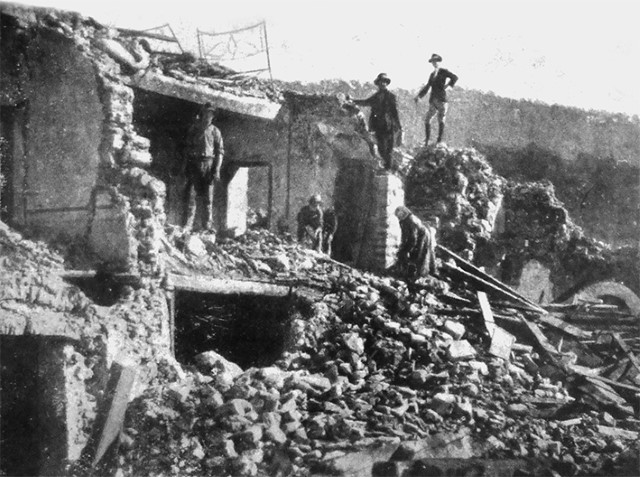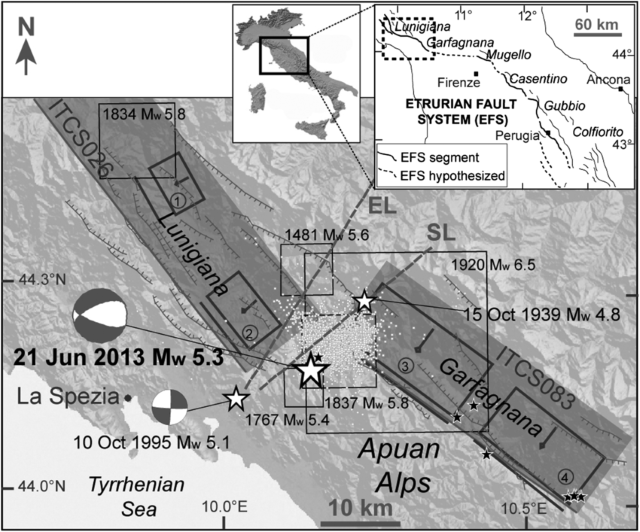
The Lunigiana is seismically active, though earthquakes tend to be of low magnitude and originate at considerable depth.
The Protezione Civile (founded in 1992) is efficient in dealing with seismic events and their aftermath. Most injuries are caused by falling masonry, but landslides are common and destructive to productive land and property. Recent disturbances can be viewed on the ilMeteo website.
The worst earthquake to hit the Lunigiana in the 20th century occurred on 7 September 1920. More recently (21 June 2013) there was an earthquake at Casola in Lunigiana, but this had much less impact in terms of injury and damage to property/infrastructure.
Property damage caused by earthquakes in the region is largely determined by three factors: the strength/duration of the seismic events, the form of construction of above ground structures, and the geological composition and characteristics of the near-surface strata.
The areas most severely affected by seismic events are those where the above-ground structures have been constructed on land comprising unconsolidated debris which tends to “liquify” when subjected to seismic vibration. Furthermore, the Apennines in the Lunigiana largely comprise alluvial and glacial debris containing small boulders, many of which have been extracted and used as building material held together with weak-mix mortar. Such structures offer little resistance to collapse when their foundations begin to move.
Fivizzano earthquake of 7 September 1920
The worst 20th century earthquake affecting the Lunigiana occurred at Vigneta in the Comune of Fivizzano at 7.55am on 7 September 1920. Its duration was about 20 seconds, with an intensity of 6.5 on the Richter Scale. Due to an earthquake the previous day, significant numbers of people stayed outside overnight and were thus unaffected. Most of the dead and injured were women and children who had remained in their homes, the men having left to work in the fields.
| Comune | Number of Dead | Number Injured |
| Fivizzano | 45 | 300 |
| Casola in Lunigiana | 19 | 60 |
| Licciana Nardi | 5 | 15 |
| Villafranca in Lunigiana | 5 | 9 |
| Massa | 5 | 7 |
| Aulla | 4 | 12 |
| Carrara | 3 | 7 |
| Bagnone | 1 | 9 |
| Filattiera | 1 | 1 |
| Mulazzo | 0 | 1 |
| TOTALS | 88 | 421 |
Vigneta and the nearby Casola in Lunigiana are prone to tremors as they sit on a saddle bridging the Alpi Apuane and the Apennine mountain ranges, the underlying geology comprising unstable materials. Technically, the African plate is moving Northwards and is being subducted under the Eurasian plate, thus pushing the Alpi Apuane and Apennines closer together.
Casola earthquake of 21 June 2013

The worst earthquake to hit the Lunigiana this century was that which occurred on 21 June 2013 in the Comune of Casola in Lunigiana, located East of Fivizzano. Mercifully no one was killed, but three people were injured when fleeing their homes, and a fourth suffered a heart attack assumed to be brought on by stress and anxiety. The village of Equi Terme was cut off for a while due to a landslide initiated by the shock wave.
According to the National Institute of Geophysics and Volcanology (Istituto nazionale di geofisica e vulcanologia: INGV), the primary seismic event took place at 8.18 pm with a magnitude of 3.6 at a depth of approximately 9.5 kilometres.
The earthquake caused significant damage to buildings in both the Lunigiana and the Garfagnana. A total of 1151 homes were afterwards deemed to be unsafe for human habitation, of which 337 were first homes: 148 in Fivizzano, 108 in Casola in Lunigiana, 45 in Minucciano, 10 in Gallicano and the remainder elsewhere. A further 814 second homes were made uninhabitable.
To gain some perspective on the scale of the destruction, it is worth reflecting that at the time of the earthquake, Casola was home to 525 families. Of these, a quarter were required to move to temporary accommodation until their property was made safe. A vide on the subject is available here (in Italian).